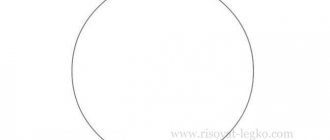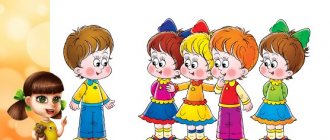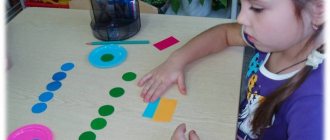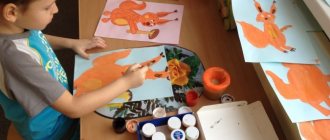Summary of GCD on the formation of elementary mathematical concepts in the middle group
Summary of GCD on FEMP in the middle group “Magic Teremok”
Program tasks: • Fix the names of geometric shapes (circle, triangle, square);
• Strengthen the ability to correlate the number of objects with a number;
• Improve counting skills within 5; • Develop memory, speech, logical thinking, imagination; • Foster independence, the ability to understand the learning task; • Develop the ability to help, friendly relationships. Equipment: Demonstration material: bibabo doll - mouse, cards with numbers and subject pictures, geometric shapes (circle, square, triangle, rectangle)
, toys
(five cubes, four nesting dolls, three bears, Masha and the bear, one hedgehog)
, four hoops , tambourine
Handouts: geometric shapes (circle, square, triangle, rectangle)
, cards with numbers.
Integration of educational areas: communication, reading fiction, health, physical education. Progress of the NOD: Educator: Children, look who came to visit us today? Mouse: Hello, guys. Do you recognize me? I am the Little Mouse from the fairy tale “Teremok”. Listen to what happened to me today. I ran to the tower, stopped and asked: “Terem-teremok! Who lives in the mansion? And the magical voice at the tower answers: “The tower will open its door only to those who complete all my tasks.” Will you help me complete the tasks given by the magical Teremok? And the tasks are as follows: Task No. 1.
“Name the geometric shapes”
- What is this?
(Square)
- Who can name this figure?
(Rectangle)
- Look carefully and tell me how a rectangle differs from a square?
(children's answers)
- How can I check?
(Place them on top of each other)
- What do we see now?
What can we say? (Two sides of a rectangle are longer than a square, and the other two are identical)
- What is the difference between a square and a triangle?
(A triangle has three angles and three sides, and a square has four angles and four sides)
- What is the difference between a circle and a square?
(A circle has no corners or sides) Task No. 2.
“Show it correctly”
(The teacher names geometric shapes, and the children pick up the geometric figure that the teacher names). Task 3.
“Find a place for the figure”
(There are four hoops on the floor, in the center of each there is a geometric figure. The teacher gives the children one geometric figure each) Educator: While I am banging the tambourine, you walk in different directions. As soon as the tambourine is silent, you need to find a hoop with your geometric figure and stand around it. (The game is repeated several times, with the children changing their figures) Task No. 4.
“Hit the tambourine as many times as the number shows”
(The teacher raises the card with the number, the child must hit the tambourine as many times as the number shows).
Physical education minute.
The cubs lived in the thicket, twisting their heads: Like this, like this
(circular movements of the head)
They twisted their heads.
The cubs were looking for honey, Together they rocked the tree: Like this, like this (raise your arms up and bend to the sides)
Together they rocked the tree.
And then they walked (walking like a bear)
and drank water from the river: Like this, like this
(body bends forward)
And they drank water from the river.
And then they danced, (“springs”)
raised their paws higher: Like this, like this
(jumping, clapping their hands at the top)
raised their paws higher.
Task No. 5.
“Count correctly”
(The teacher puts object pictures on the easel. Children must correctly correlate the number of objects with the number). Task No. 6.
“Find a house for each number”
(The teacher distributes a card with a number to each child. On five tables there are toys: five cubes, four nesting dolls, three bears, two heroes from the fairy tale “Masha and the Bear” and one hedgehog. The teacher distributes them to the children cards with a number and shows five houses where toys live. At a signal, the children find the house for their number and stand near it. The teacher together with the children checks whether everyone has found their house correctly.
You can exchange cards and play a few more times).
Educator: Guys, you completed all the tasks correctly, so the doors of the magic tower are open for the Little Mouse. Let's say goodbye to the Mouse, she needs to hurry to her fairy tale. And if Little Mouse needs our help again, we will definitely help her. Really, guys? Mouse: Thanks, guys. You helped me a lot. Goodbye. Educator: Who came to visit us today? What happened to her? How could we help her? What tasks did we complete? Did you enjoy helping Little Mouse? (Children's answers).
We recommend watching:
Summary of a lesson on the formation of mathematical concepts for children of the middle group. Notes of educational activities on cognitive activity (mathematics) in the middle group. Our flag Notes on mathematics in the middle group Notes on cognitive development in the middle group of kindergarten
Similar articles:
Math lesson notes “Number 1”. Middle group
Summary of mathematics lesson “Number 2” in the middle group
Summary of mathematics lesson “Number 3” in the middle group
Summary of mathematics lessons in the middle group. Digit 4
Summary of mathematics lessons in the middle group
Goal: formation of elementary mathematical concepts in children in joint play activities.
Tasks:
Educational:
· continue to consolidate the direct count to 5 and back; the ability to find neighbors of a number; distinguish and name geometric shapes;
· consolidate knowledge of the color spectrum of “Cuisenaire Rods”;
· consolidate the ability to determine the size of objects based on comparison and with the help of an eye;
· consolidate the ability to navigate in space: left, right, above, below.
Educational:
· develop memory, logical thinking, imagination, fine motor skills, speech.
Educational:
· cultivate emotional responsiveness and a desire to help others.
Types of activities: gaming, educational, communicative.
Equipment: tickets with drawn geometric shapes, houses made of geometric shapes, numbers, educational games.
Methods and techniques: playful and surprise moments, problem situations, didactic games, demonstration, conversation, questions, generalization, summing up GCD.
Progress of the lesson
Organizing time
The teacher welcomes the children.
Educator: What is mathematics?
The children answer.
Educator: In mathematics we learn to count, recognize and correctly name geometric shapes, compare objects by height, length, width.
The teacher creates a problematic situation.
Educator: Children, look, a resident of the country of Mathematics, Prince Five, came to visit us. Look closely at him. Who can describe his appearance and costume to me? (a young man with long dark hair and a blue cloak decorated with stars, sandals on his feet).
Educator: Prince Five brought us gifts (a pentagon and a flower with five petals). Why do you think he brought us these items? (children's answers)
Educator: Tell me, do you like to travel? (children's answers)
Prince Five invites us to take a trip to the Land of Mathematics.
Children, what can you ride? (answers)
We'll go by bus.
The teacher hands out tickets with geometric shapes to the children. Children sit on chairs with their geometric figure.
Ask why the child sat in this particular place.
Organizational and practical stage
Educator: We have arrived in the country of Mathematics (the teacher leads the children to the easel).
Look at the unusual houses here. They are built from geometric shapes. Which ones? Please name these figures.
Children name geometric shapes: (square, circle, rectangle, triangle).
Educator: Well done! Everything was named correctly.
Look, here is the figure that Prince Five brought us. What is it called? (children's answers).
And you know that it can also turn into a house. (showing a house made of a pentagon).
Educator: Residents of the country of Mathematicians love order in everything. So the houses on the streets in the country of Mathematicians were arranged in order from lowest to highest. But a strong wind blew in and caused confusion. You need to arrange the houses in height from lowest to highest.
Educator: Well done, you completed the task.
Physical education minute
Educator: Now, guys, let's move on. In the country of Mathematics live not only numbers and geometric figures, but also animals.
The teacher shows the squirrel.
Look who it is? (children's answers).
Educator: Guys, Squirrel was collecting mushrooms. But she was in such a hurry to get home that the mushrooms scattered and the caps came off. Please help Squirrel match the mushroom cap to the stem, otherwise she has just started learning numbers.
Didactic game “Fly agaric mushrooms”.
Educator: Well done, guys, you helped Squirrel a lot.
Educator: Guys, look how many flowers there are in the clearing! They are also unusual, they have some kind of number (5) written inside them. Tell me, what is this number? (children's answers).
Educator: Let's collect the flowers in two baskets. Red flowers go in one basket, and blue flowers in another.
Game "Collect flowers".
Educator: Let's check if you did everything correctly.
Educator: Guys, now it’s time for us to hit the road again.
Look what a puddle it is. We need to cross it so as not to get our feet wet.
Outdoor game “Jump over the puddle”
A drawn puddle of paper. On it are “pebbles” (circles made of cardboard) with numbers. You need to jump in order from 1 to 5.
Educator: Well done, everyone completed the task!
Educator: Guys, look, the Bunny meets us here!
Educator: The bunny needs help. The fox kicked him out of the house. And he needs a new house. Can we help build a house for the Bunny?
Working with Cuisenaire rods. Handouts for each child.
Educator: You will build a house for the Bunny according to the diagrams that lie in front of you.
Guys, let's see what the house has (walls, roof, window). What will we build from? (From sticks).
Educator:
Look carefully which sticks we should use when building a house. Let's start work. (Children build a house out of sticks ).
Educator: Well done, they built a house.
Physical education minute
One two three four five. Let's build and play. (Children jump on the spot.) We are building a big, tall house. (Stand on tiptoes and stretch arms up). We are installing windows and roofing. (Show the window, the roof with your hands - clasp your hands above your head). What a beautiful house! (They extend their arms forward with an index gesture.) Guests will arrive (rotate an imaginary steering wheel in front of their chest). Relax in our house (put your head on your palms and close your eyes).
The final stage. Bottom line
Educator: Guys, our journey is over. It's time for us to go back to kindergarten. Say goodbye to Prince Five. We take our tickets and take our seats on the bus.
Did you like the country of Mathematics? What did we do? Which tasks did you like best? Why? Which task was the most difficult?
(Praise the children by name)






